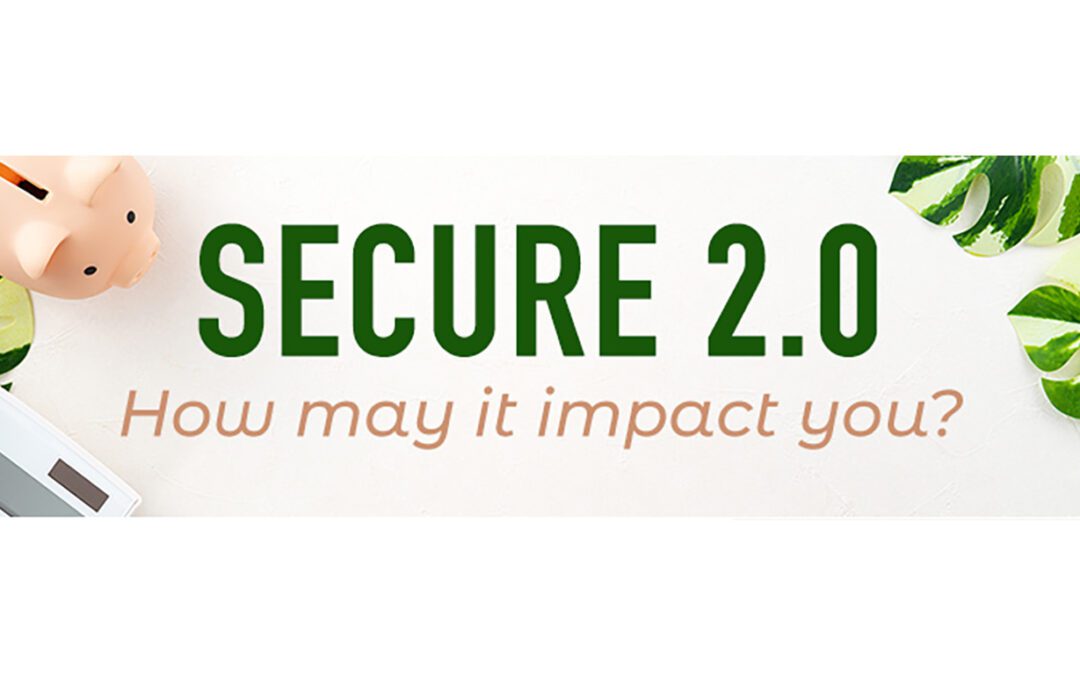Are you retired, saving for retirement, a business owner, or saving for your child’s education?
A new set of regulations went into law in December, designed to improve retirement readiness nationally. If you fall into any one of the categories above, it may have implications for you and your retirement.
Here’s how (and why) you need to pay attention to the Setting Every Community Up for Retirement Enhancement (SECURE) Act 2.0.

If you are self-employed, you can now contribute to SIMPLE and SEP IRAs.
If you or a younger member of your family hasn’t started saving for retirement yet, automatic enrollment will now be the norm. Beginning in 2025, all new 401(k) and 403(b) plans will be required to automatically enroll eligible participants at a minimum of 3%.
If you are approaching retirement and you’re worried you haven’t saved enough, catch-up contributions will increase for 401(k) plans from $20,500 to $22,500. Savers over age 50 can make catch-up contributions of $7,500, up from $6,500. Anyone between the ages of 60 and 63 will also be eligible for higher catch-up limits beginning in 2025. Maybe even more importantly, catch-up limits may rise annually beginning in 2024 based on cost-of-living changes.

The new rules offer incentives for business owners that launch a retirement plan for their employees. If you introduce a plan this year, you will be eligible for a tax credit. Employers with up to 50 employees will be eligible for a credit equal to 100% of the amount contributed by the employer, up to $1,000 per employee. The employer receives a credit equal to 100% in years one and two, then 75% in the third year, 50% in the fourth year and 25% in the fifth year. Small businesses with 51 to 100 employees are also eligible for this tax credit, which phases out based on the number of employees exceeding 50 during the preceding taxable year.
Beyond tax incentives, employers will have the option to match the Roth IRA portion of a plan. This is an interesting new option, especially for generous business owners.

Good news: The SECURE Act 2.0 raised the age for required minimum distributions from 72 to 73 in 2023 and then to 75 in 2033. RMDs force savers to take money out of tax-advantaged accounts, like IRAs and 401(k) plans annually. But with people living and working longer, the new rules are designed to help stretch your savings.
This may help when it comes to taxation, estate planning, and even your Medicare bill. These premiums are tied to income, and distributions from pretax retirement accounts increase your income.

Many parents are using 529 plans to help offset their children’s education. Previously, money in 529 plans could only be used to fund education. Beginning in 2024, money left over (maximum lifetime amount available to convert up to $35,000) in a 529 qualified tuition program will be eligible for a tax-free rollover to a Roth IRA. The beneficiary of the 529 account and the Roth IRA must be the same, and the 529 account of the beneficiary must have been maintained for at least 15 years.
For younger savers, many are forced to choose between repaying college loans or saving for retirement. Beginning in 2024, employers can make matching contributions to a retirement plan based on a participant’s student loan repayments.
For a full breakdown of all the changes, click here.

This is only the tip of the iceberg and there are many details we are still unpacking. Though most provisions will take effect in 2024, now may be a good time to reexamine your retirement savings strategy.
We are always keeping our eye on the horizon, and we are happy to sit down to see how we can put the new rules to work for you and your family. Simply reply to this email to schedule a meeting.







